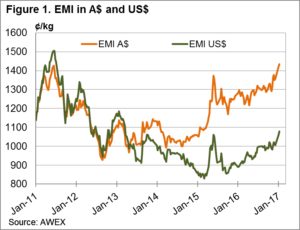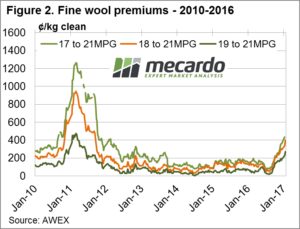Is it a record? Maybe yes, maybe no.

The first week of sales for the new year last week 
opened with a bang, the EMI smashed through
1400 cents, while the WMI reached almost 1500
cents. (WMI has little influence from X Bred prices).
This week the good times continued, prompting
AWI to announce the wool market was at an
all-time record. This statement needs a little more
detail to confirm; the wool market across the board
is not all at record levels.
While not wanting to dampen down the enthusiasm,
the wool market covers a wide range of types, not all
are trading at highs. It also needs to consider the
timeframe; the high this week of the EMI still hasn’t
overtaken the April 1988 high of 1523. As Mecardo
followers will know, we also look at the price the
processors are paying to determine how strong is
demand; so, when looking at prices do you consider
the price from the buyer’s perspective or the seller’s
perspective? We think that while the price the grower
receives is important from an Australian viewpoint,
the cost to the buyers is a truer reflection of demand.
In Au$ terms the June/July period of 2011 was the
previous recent high for the EMI – 1426 cents.
At this time the A$ was trading at US$1.07, causing
the processors to shell out US$ 1500 cents. Note 
that this week the EMI in US$ terms is still below
1100 cents. (Fig 1.)
The positives to the above analysis is that in this
scenario everyone is happy. Buyers receive regular
orders when the market is rising; processors don’t
want to miss out and a strong market resonates
confidence all the way up the wool pipeline. The
lower A$ (compared to peak levels when it traded
around parity) is keeping prices for the ultimate
end customers below previous peaks. Happy sellers,
happy buyers – the true definition of a “win-win!”.
On a cautionary note, the EMI high reached in the
winter of 2011 was then followed by the recent history
low point of 946 in September 2012. The market then
wobbled along with the EMI oscillating between
1000 + 1140 until early 2015 before the beginning of
this current positive run. Out take on this rear view is
that markets are continuously moving; so at “record”
levels locking in some of the future clip needs to be
considered. As one grower said, this is the time to
“kick the can as far down the road as we can!”
The trend of improving fine wool premiums continued
this week, we are now seeing the highest “basis” levels
since January 2012, however as Fig 2 shows, we have a
long way to run to get back to the heady days of 2011.
It is great to see that the 18 – 21 MPG basis has doubled
to 400 cents since October last year, fine wool producers
should begin to feel that their product is again on the up.
A challenge for the industry if, as is expected, the market
remains strong but supply stays static, is that the wool
trade may become frustrated that higher prices are not
encouraging increased production. As Andrew Woods
reported, sheep numbers in these bumper times are
only forecast to rise by 1.4% next year.
The Week Ahead
The offering of next week is below 50,000 bales so after a
couple of big offerings supply is easing, and based on reports
from traders the market is going to continue to remain active.
It would be unusual to see the market continue to rise at the
same rate as the last 2 week’s (not unprecedented though!),
so on balance a steady week ahead with a continuance of
strong demand for selected lots of the better-quality fine types.


